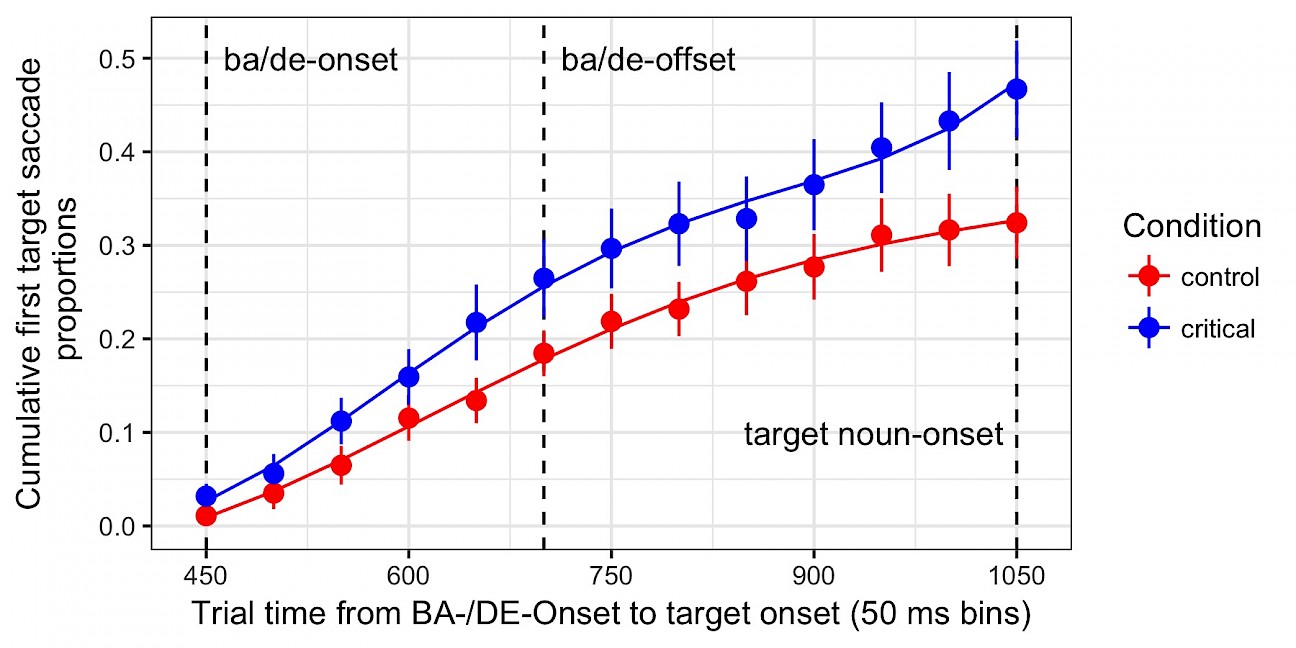Predicting object states in Mandarin Chinese - insights from the bǎ-construction
One of the most discussed phenomena in Mandarin Chinese is the so-called bǎ-construction. Besides other functions, the marker bǎ changes the canonical word order S-V-O to S-bǎ-O-V; it marks the noun to which it belongs as the direct object (cf. Yang & van Bergen 2007), and it signals that the corresponding referent (in a transitive sentence) must be interpreted as having changed from one state to another (cf. Li & Thompson 1981). It is this latter aspect that we focus on in the current project.
Previous studies revealed that, while listening, people use the current linguistic input to predict upcoming discourse (cf. Altmann & Kamide 1999). It is assumed that this is due to the comprehension processor attempting the fullest interpretation possible at all times (cf. Kamide et al. 2003, Crocker et al. 2010). We thus hypothesized that the function word bǎ should trigger predictions about to-be-perceived referents following it.
Experiment 1: In a visual world paradigm, we measured the start time of saccades directed to target objects under 2 conditions: In the critical condition, an auditorily presented target noun followed bǎ, whereas in the control condition it followed de, a possessive marker in our context. This yielded sentence pairs such as tā bǎ xiǎoshuō sī huài le/tā de xiǎoshuō bèi sī huài le (‘He bǎ novel rip apart’ / ‘He de (=His) novel was ripped apart’). Auditory onset times of the target (xiǎoshuō ‘novel’), the respective markers (bǎ/de), and the pronoun (tā ‘he/she’) were kept constant in all trials. The visual stimuli always showed three objects, one of which was unambiguously depicted in a resultant state, e.g., a torn book or a broken pencil. There were 12 bǎ/de stimulus pairs in total and 12 fillers. 26 Mandarin native speakers participated in the experiment. Two experimental lists ensured that every subject encountered only one pair-partner, 6 from each condition (but all fillers). The participant’s task was to click on the object mentioned in the sentence. Our analysis focused on the cumulative frequency of target-saccades in the 50-ms-time bins after bǎ/de-onset and before target-onset.
Results revealed a reliable effect: There were significantly more pre-noun target-saccades in the critical (bǎ) compared to the control (de) condition. Furthermore, the cumulative proportions of first target-saccades increased significantly more rapidly (Fig 1).
Experiment 2: Results of a second experiment confirm these findings and rule out alternative explanations. Only sentences like those in the critical condition in experiment 1 were used (He bǎ noun …). The nouns matched a visual target that this time was not depicted in a second state. Instead an irrelevant visual second-state competitor (torn book) was either present (critical), or not (intact book) (control). Participants looked faster to the target if the second-state competitor was not present. In addition, more pre-target saccades were registered to the competitor in the critical condition than in the control condition.
Our findings suggest that processing bǎ pre-activates an abstract resultant state for one referent (the syntactic object) in the listener’s situation model. Visual objects depicted in a resultant state are automatically linked to this ‘open slot’. In our design, this shows as a prediction effect. Neither potential effects from using the de-marker in the control condition, nor a task-specific strategy can explain the results obtained in experiment 1.
Experiment 3: Currently we are conducting a sentence completion experiment, in which we assess whether participants choose different objects to construct a sentence when they are given different lead-in fragments. Again we manipulate the visually depicted object states.

Project publications
- Predicting object states in Mandarin Chinese – insights from the bǎ-construction
Gerwien, J. & Kexin Xi (poster presentation). Predicting object states in Mandarin Chinese – insights from the bǎ-construction. 30th Annual CUNY Conference on Human Sentence Processing, March 29-April 1, 2017, Boston, Massachusetts. abstract and poster